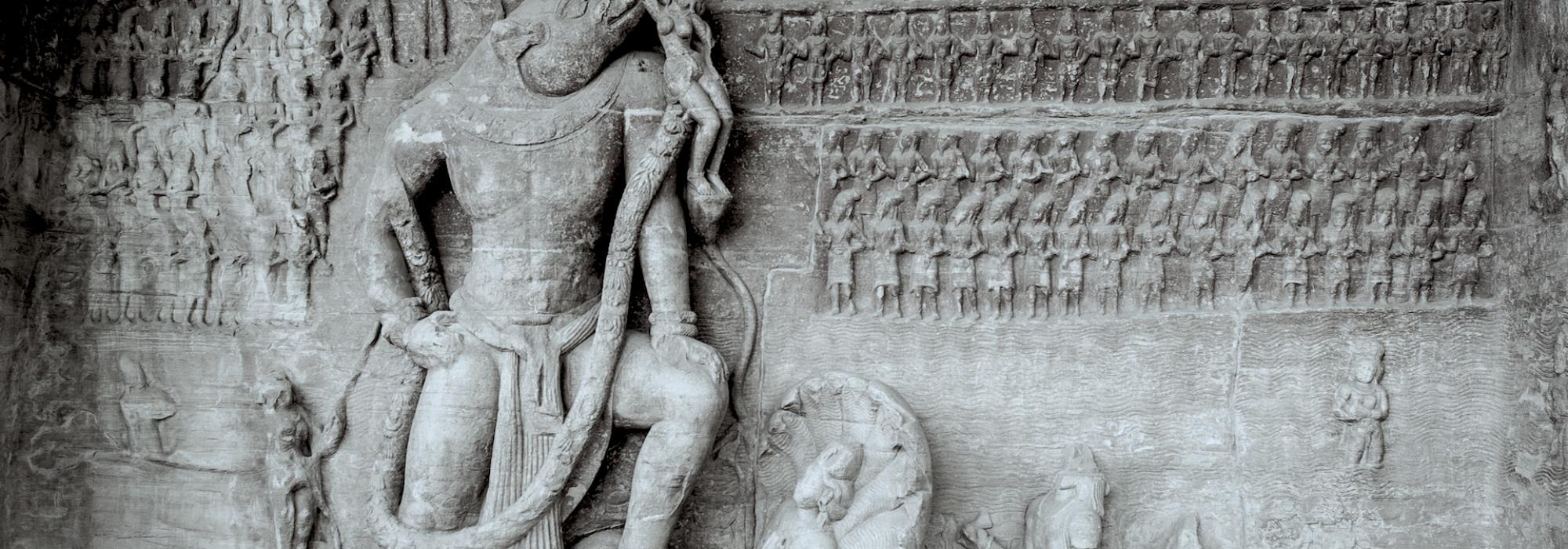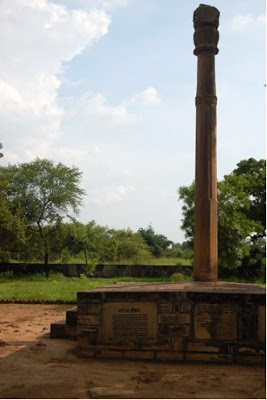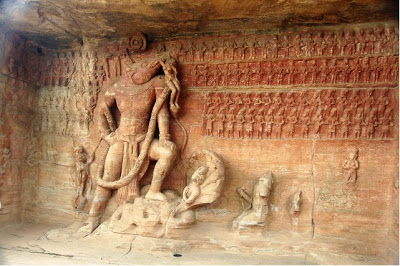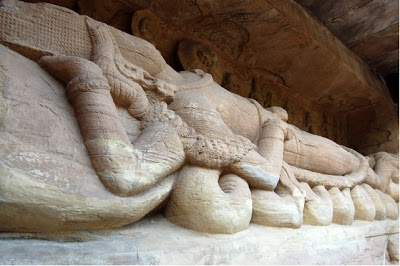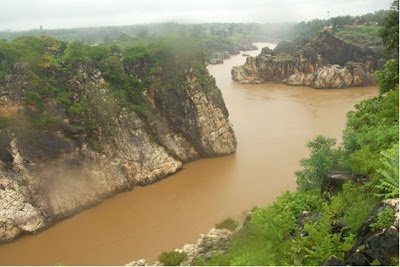After a very well spent morning at Sanchi and being fully satisfied, we drove to Vidisha. Lunch was foremost on the agenda. After enquiring with locals, we were directed to a ‘Jain bhojanalay’, a nondescript, unassuming luncheonette on the first floor of a dirty drab building close to the railway station. We had made our way there through the not-so-healthy ‘Hospital road’. But the food was a refreshing contrast. The ambience was forgotten in the taste and aroma of the food. Varieties of curries, dal, phulkas, rotis came in quick succession to the table and promptly vanished. The bill of just about Rs. 350 was a pleasant finale. Nigh, the paan was.
The paans began to be rolled in a paan-shop opposite and during this time, G had made enquiries about the Heliodorus pillar. The ‘Lonely planet’ guide that JM had carried along had given us the crucial piece of information that this pillar was locally popular as ‘Khambaba’. It was on the way to Udaigiri and just about two--three kilometres from Vidisha. We made a brief stop, stood by and saw the pillar that’s so significant in history.
We then proceeded to the Udaigiri caves. There was a lot of anticipation. This was another place that finds a prominent mention in Kalidasa's Meghadootham, albeit as a forewarning to the Megha of Udaigiri’s fallen reputation. We anticipated the grand Varaha to extend a towering welcome. We reached there in about 15-20 mins. And as had never happened in the whole tour, we were not disappointed. The grand and the imposing Varaha in its towering, nonchalant, frozen gait, overwhelmingly dwarfed us. It was indeed a masterpiece of a sculpture!
V had especially been anxious to see this. We spent a few minutes photographing the Varaha and ourselves before proceeding to the caves. The Varaha stands tall underneath the high rocky mound, as if holding it up, inside which the small caves have been carved out. In the Meghadootha, the yaksha warns the Megha not to hover for long here, lest be swayed by the scent and sights of nefarious and carnal pleasures that these caves had become abode to.
नीचैराख्यम् गिरिमधिवसेस्तत्र विश्रामहेतोः
To rest, go to Neecha(modern Udaigiri)
Nevertheless, in one of the caves is the beautiful sculpture of Seshashaayi Vishnu
We coaxed the guard there to open the mesh gate so that we get an unrestrained view of the reclining-beauty. We clicked photos and then went up to a high mound opposite the caves that gave a bird’s eye view of them. In fact, the caves become clearly visible only from a height. We stood at this vantage point for a while as if to vindicate the aptness of this description in the Meghadootha. We climbed atop the mound and then followed a track that was supposed to lead us to a few more caves. Though we did not find any more interesting caves, the little trek was quite enjoyable. The cool breeze brought a sprinkle of rain for a brief while. Meghadootha had enlivened yet again as the clouds softened ever so briefly. The yaksha’s advice was not forgotten. The clouds had refused to stay long and relent. Along wth the clouds and with yet another eyeful of the Varaha, we too left Udaigiri.
We were still unsure of our next destination. We had learnt of Udayapura. We only had information that it was a couple of hours from Vidisha, but did not know what to expect there but decided to risk a visit. V was especially keen. Not that he had any more information about the place than the rest of us. He was only willing to risk it, for he believed that we would rather not feel sorry about having missed something interesting, especially when we have gone so far. So, Udayapura it was.
We were traveling now on the narrower roads of interior MP. It was cloudy and the skies were darkening quickly. Downpour began. It was torrential. From within the comfort of our vehicle, we saw the heavy rains bouncing off the road and the hard wind sweeping the waters in a mesmerizing show of unorchestrated dance. The vast vistas of green fields on either side of the road bowed down to the rains in gratitude while the winds seemed to roll and glide on the soft green cushion, frolicking and singing loudly in elated mirth. As much as we liked to watch the grand show of nature, we were apprehensive that it would become dark by the time we reached Udayapura. But no. Nature was kind to us. We were slowed down only for a short while.
After making some enquiries, we reached Udayapura even as the Sun was warning to retire for the day. Through narrow and crowded streets, we reached the precincts of the temple. And suddenly in front of us was a beautiful, huge, imposing temple in red stone. The temple, with its high Nagara shikhara bodied with highly intricate sculpture stood aloof in a huge compounded courtyard, defying the noise and filth that had led us there.We gasped in pleasant exclamation as we saw the beautiful carvings on its exterior.
It was a vindication for V. His gamble and insistence had paid off, and wonderfully! We went around the praakaara, with AG explaining the different sculptures and the architecture of the temple. AG described how the structure was a symmetric piling up of seven or eight layered squares, one on top of the other and shifted/rotated by some degree(s). Many of the scupltures had been vandalized. We didn't to look elsewhere to find the answer to how the perpetrators of this barbaric vandalism were. Within the outer praakara and at the entrance itself are two huge (remnants of) doorways, distinctly Islamic and etched in Persian/Arabic. It must have been converted at some point in time into a Muslim prayer area. Anyway, ignoring the vandalized sculptures, we went around the praakara listening to the detailed commentaries by AG. In the four corners of the outer praakara were four different (sub) temples. Only two of them remain. We sat there for a few minutes in the mantapa watching the Sun go down. The Sun set, but cast its crimson colours over the temple.
Of course, it was time for poetry. Inspired compositions flowed impromptu from both V and AG. The treat at Udayapura was unexpected and pleasant.
We took leave of the temple. Just outside the compound was the same bustling crowd. We saw people and people and more people all around. The crowd had no apparent reason to be there. It just was. Udayapura was a fulfilling experience.
Bheda Ghat
Our next destination was BheDa Ghat. We had originally planned to reach Jabalpur for that night’s stay but it was quite a distance from Udayapura. We set out neverthless. After this journey through the evening to Udayapura, we wondered if we could really make it to Jabalpur. We left it to the discretion of Paramaar. He seemed inclined to take a break. After dinner at a dhaba near Sagar, we sought accommodation nearby. It was beyond 12 in the night. At a lodge close by, we got a pretty good deal for the night, brokered by Paramaar. We spent the night in a large dorm that accommodated all of us.
We awoke early next morning, finished our ablutions and set out to BeDa Ghat. The drive took us through the thick green forests of Panna. We stopped for a while at a nice enticing stretch in the national park, strolled along the road for a short distance, savoured the luscious greenery rendered fresher by the rains, breathed deeply the refreshing air, clicked a few photographs and continued onwards to BeDaGhat.
[contextly_sidebar id="tTOfAFEKUzW6iEur7DHa18tGEfbgLshh"]
It was around 9 AM when we reached the place. Breakfast undoubtedly topped our priorities. We went to a restaurant which seemed decent. All of us ordered (varieties of) paranthas. It was indeed tasty, filling and hearty. But, the bill was not as friendly as had been until then. We were instantly reminded that we were at a ‘tourist’ destination. The bill was over Rs. 600! But the owner of the restaurant arranged for a guide to go with us and show us around. It was apparently a short walk to the vantage point from where one could see the Narmada slicing through the white marble rocks.
As we began the trek, the rains began. It wasn’t hitting hard, but was steady. A concrete path has been laid out that we followed. As we neared the vantage point on a high precipitous ridge on the right bank of the river, we saw the course of the Narmada meander through the abalaster canyon. Getting a bird’s eye view of the Narmada cutting through the white deep canyon was indeed spectacular.
The rain got harder. We were getting drenched, but we cared little. While we saw and heard the gushing waters of the river, the rains ensured we feel it too. Our only worry was how to protect the camera and yet capture the spectacular scenery. We did manage a few photographs. Our guide, with his witty repertoire of poetic expressions, rendered an interesting commentary of the place.
During the season when the Narmada is more sober, boats are operated under floodlights even at night. They ferry on the course of the river amidst the high marble precipices almost up to the ‘Dhooan dhaar falls’. But now it was monsoon and no boat would dare ply on the swollen river. Our guide with his almost prosodic commentary reeled out the name of every movie and song that had been filmed there. It is no surprise at all that many a movie and song found inspiration there. We began to head back. The rains seemed to be in a hurry to fill up the Narmada. We had given up trying to protect ourselves. Instead, we submitted ourselves to the rains and enjoyed it.
A short distance away is a ropeway that takes us across the Narmada, over the Dhooah-dhaar falls. We scrambled in to our vehicle and drove a small distance, bought the tickets and got onto the rope car. It’s a less than a ten minute ride across the river and affords a fantastic birds eye view of the falls and the landscape. The rains had not ceased. True to the name of the falls, a spray of mist was rising from the bosom of the falls. Like two good friends rushing to meet each other, the descending clouds lay out a hug on the rising mist. The cascade is not deep, but is spread across a considerable area. As we saw the waters gushing down on the rocks, Meghadootha came to life yet again. The Narmada was indeed flowing gracefully draping in white, the backs of the elephants. Or so it seemed as we watched the white, milky water flowing down the rocks as if elephants were ornamented with it.
रेवाम्द्रक्श्यस्युपलविषमे विन्ध्यपादे विशीर्णाम्
भक्तिच्छेदैरिव विरचिताम् भूतिमंगेगजस्य
O cloud! You will see the river Narmada rolling at the rocky feet of the Vindhyas. The gushing river looks like the white bands of embellishment that are painted on a tusker.
We got a good view of the falls from the left bank. We felt the soft caress of the misty spray inspite of the rains. At a small tea shop nearby, we helped ourselves to some hot masala chai and headed back, drenched to the bones. The rains that drenched us in the memories of Bedaghat will not dry up soon.
Concluded in the next part

